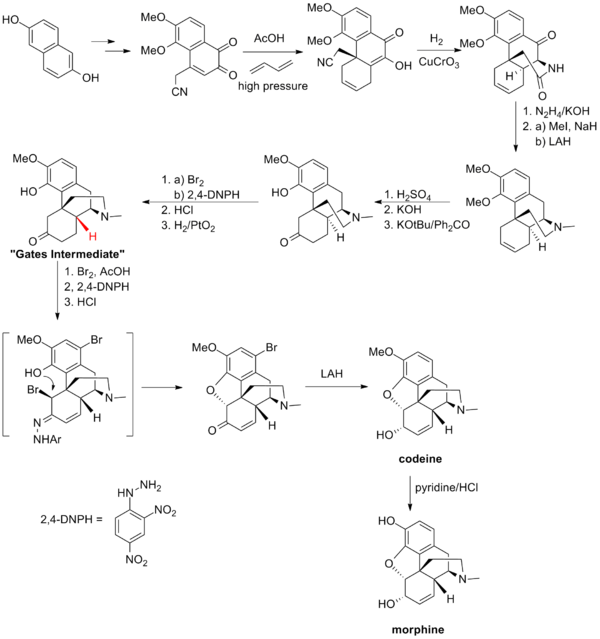Marshall D. Gates
Marshall DeMotte Gates Jr. (born September 25, 1915 in Boyne City , Michigan , † October 1, 2003 in Pittsford ) was an American chemist ( organic chemistry , synthesis of natural products) and professor at the University of Rochester .
Gates graduated from Rice University with a bachelor's degree and a PhD from Harvard University . From 1941 he taught at Bryn Mawr College and from 1949 until his retirement in 1981 at the University of Rochester. During World War II he worked for the National Defense Council. In 1968 he became CF Houghton Professor .
In 1952 he published the first total synthesis of morphine . It confirmed the then 27 year old structure determination by Robert Robinson .
It begins with dihydroxy naphthalene , from which a cyano-diketone derivative is produced, and then with a Diels-Alder reaction under high pressure with butadiene, the basic structure of three rings. An important step was the Gates intermediate state (Gates Intermediate). In the above figure, the use of the wedge formula must be observed (continuous wedges point out of the plane, dashed wedges point into it). In the intermediate state of Gates there is a three-dimensional change of position of a hydrogen atom (highlighted in red) and at the same time the bridge of two carbon atoms from the nitrogen atom. His total synthesis ( Gilg Tschudi was also involved ) was considered a milestone and influenced the synthesis of other alkaloids. Gates began studying morphine at Bryn Mawr College. In practice, the total synthesis is too complex and other synthesis methods are used for morphine.
He later tried to find morphine analogues that were not addictive, but were similarly potent. He was considered a very good teacher and in 1967 received his university's highest award for undergraduate teaching.
From 1949 to 1969 he was associate editor and then chief editor of the Journal of the American Chemical Society . He was a member of the National Academy of Sciences (1958) and the American Academy of Arts and Sciences (1959),
He held 13 patents.
Gates made many glass devices himself as a glass blower. He was a passionate poker player, active skier and sailor who also built his own small sailing boats in addition to model boats. Gates was married to Martha L. Meyer and had two sons and two daughters.
Web links
- Marshall D. Gates, Chemist to First Synthesize Morphine, Dies , University of Rochester, October 3, 2003
- Chemistry Tree
Individual evidence
- ^ Gates, Tschudi, J. Am. Chem. Soc., Vol. 78, 1956, pp. 1380-1393
- ↑ Website at the NAS
- ↑ Book of Members 1780 – present, Chapter G. (PDF; 931 kB) In: American Academy of Arts and Sciences (amacad.org). Retrieved March 27, 2019 .
| personal data | |
|---|---|
| SURNAME | Gates, Marshall D. |
| ALTERNATIVE NAMES | Gates Jr., Marshall DeMotte |
| BRIEF DESCRIPTION | American chemist |
| DATE OF BIRTH | September 25, 1915 |
| PLACE OF BIRTH | Boyne City |
| DATE OF DEATH | October 1, 2003 |
| Place of death | Pittsford (Town, New York) |
